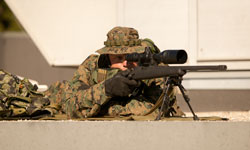jail use of force - pre trial vs sentenced
Login to reply
 commander
277 posts
commander
277 posts
|
A friend of mine moved to South Carolina and works in a County Jail down there. He was a Lt. with me at our former prison. He told me he quickly had to learn a very important lesson. Most of the Inmates in the jail haven’t been tried and convicted yet. So basically, he said he would not use the force he used at Luc when breaking up a fight. They also carry tasers at the jail. He commented on how much nicer and more orderly the jail was run and operated. He says that is probably due to the Inmates at the jail not wanting to get additional charges and the ones in prison not caring. |
 jamestown0509
313 posts
jamestown0509
313 posts
|
Yes absolutely true. As they say in state prisons…have a safe shift. I would rather an officer call for backup and not need it than to get into a bad situation screaming for help with only one other officer to assist them. We wear black uniforms (no badges, pins, nameplates) all embroidered so we don’t get injured during a fight or backup call. |
 irish assassin
286 posts
irish assassin
286 posts
|
Yep, we all know when an inmate decides they want to assault staff that its game on. My general response was based on the general SOP they feed us every year in training. In no way was it an attempt to say anything about the quality of staff you work with. I just found it odd that a department would tell the staff to “match” the force being used, instead of going one higher to quickly neutralize the threat. In the prison where I started working in maximum security we had what everyone knew as the “Grey Wave”. Thats when an alarm went off all you could see coming down the hallways was a wave of grey C/O shirts. The “white shirts” or supervisors would show up a little later cause they usually had a longer way to go to respond. Always gave me a good feeling knowing if I ever got in trouble that the fellow staff would come running. I completely agree with you with doing what is intended in these situations. We all watch out for one another and we all go home safe after shift. |
 jamestown0509
313 posts
jamestown0509
313 posts
|
Well Irish that’s what the SOPs say but you know as well as I do that once an inmate goes after a CO its our turn. We do the best we can depending on the amount of officers that respond but in almost all cases I have seen at least 20 officers come for a backup call with one inmate including a supervisor. It seems they would like us to use verbal judo or communication skills prior to going in with force. The problem is when an inmate gets into a fight with another inmate in the open out of the cellblock or with an officer that a free for all ensues. I recall one fight during recreation where we had 8 inmates pounding on each other at the same time. The officer on the floor was a NY state CO working part time for us and she cleaned clock almost by herself before we got to the floor, not a CO to mess with. I do think you need to do what you intend in these circumstances. Don’t say your are coming into the block if you really aren’t. |
 irish assassin
286 posts
irish assassin
286 posts
|
Only equal to what the inmate is using? Here in Ohio they tell us to “Play to win” and do that by going one step higher on the use of force table than what the inmate is using. |
 jamestown0509
313 posts
jamestown0509
313 posts
|
In New York the use of force is covered by PL 35.00. All officers of the law must comply with this law regardless of position. We get retrained once a year in the use of force and the use of force continuum. In general if an inmate stops resisting, you stop. If that same inmate again starts to attack or assault then you are allowed to use use of force equal to what the inmate is using (hard hand techniques for example). As stated below the one thing you must never do is to over-react and keep trouncing and pounding on an inmate, that’s excessive use of force and that will get you in real hot water with the department and leave you open for a lawsuit. |
 larryh2420
1 post
larryh2420
1 post
|
Try the Orange County Corrections in Orlando Florida. They are not with the road patrol.Or with the Sheriff Dept |
 UFO
1 post
UFO
1 post
|
unfortunately you have the 14th and 8th….but they’ll take the 5th!!! |
 OTCDFCERT
2 posts
OTCDFCERT
2 posts
|
If I am reading this correctly, your jail is using the same UOF policy as the road deputies. I will address this. The main difference between jail and road UOF incidents is timeliness. By this I mean you have to react at the appropriate time with the appropriate amount of force. The difference between the departments is that in general, time is on our side in corrections. Where a road deputy may need to take immediate action to apprehend a resistor, corrections usually has time to isolate the incident and offending party before taking action. Also, in theory, corrections should have greater access to sheilding. Because of the availability of time and sheilding, the objectively reasonable standard IS different between road and corrections. As far as policy goes, both are similar in that we (government) have to maintain control. The need for control is higher in the jail, because we can reasonably assume that there is nothing good in jail. By this I mean that no inmate(and often times staff) want to be there. So we basically have a situation where a neutral person is as good as it gets, and it gets continually “badder” from there. Therefore we HAVE NO CHOICE but to maintain a high level of control. Road officers are dealing with the public where some good things happen and good people are. They MUST weigh the needs of society against the the rights of the individual when using force to control persons, for there is NO NEED of control over someone following rules, laws, and social moras. The courts do recognize the need for more control in a correctional setting, as long as it is reasonable and neccessary(8th amendment). A good example is restraints. A cooperative person in jail wearing restraints to court is probably not excessive force, but placing shackles and belly chains on someone appearing for court from the street probably is. UOF policy should mandate that force only be applied in a situation where control is needed and timely. The person walking in of their own free will to appear in court has no need for force(restraints) when the one from the jail does, just because of the nature of jail. As far as a different policy for sentenced and pre-trial detainees, the standard of control remains the same with resistors and assailants. Although you may have them seperated in different areas with access to different items and programs, you would still react to resistance to control the same way. Failure to obey a lawful order is failure to obey a lawful order no matter where an inmate is housed, and CO’s have to maintain safety and security of the facility. You may want to avoid using words like shall and must when writing your policy. Instead use may and can. Placing a prescibed response to a situation is a sure way to lose in court. This is where use of force “continuums” fail. If you dictate that an officer shall do something in response to an inmates actions, you have handcuffed your staff into doing something that may not work. If your “continuum” says that you shall respond to an active resistor with a taser or OC, then your staff are in fact violating policy if they control them with an escort hold, or with a stun, or a trip, or whatever, because it is not a taser or OC. Instead policy should say to respond with an appropriate amount of force. Thats it. Nothing fancy, just simple. By doing this, you are allowing staff to use all the tools available to them to gain control, as long as they are not unneccassary or excessive(4th amendment). Sorry about being so windy. Good luck with writing your policy! |
 JIMP
1 post
JIMP
1 post
|
I think creating two different policies is opening a can of worms. Unless you have two different missions assigned to your facility and can completely isolate the different populations, you must consider the 5th and 14th Amendment requirements for equal treatment under the law. Once you can satisfy the equal treatment requuirement, then you need to satisfy the two most challenging requirements, that any use of force be BOTH necessary and reasonable. It matters not whether you are holding a juvenile, a female, a detainee, or a known serial killer. The jail is not the place to determine guilt or to punish. Its sole mission is to hold the person for the court to process or for the court mandated period of separation from society consistent with state law. The jail staff are authorize to use force only to accomplish the legetimate mission of the jail or the agency running it. Virtually all agencies have some sort of UOF policy based on levels of resistance vs. levels of force. They all attempt to guide the jail staff in selecting only the level of force necessary and reasonable in a given situation, and only until the subject is brought under enough control to accomplish the legitimate agency mission. One policy is challenging enough to get right. Two different policies would be a nightmare for your agency and gift to a plaintiff’s attorney. |
 oyochickporvida
3 posts
oyochickporvida
3 posts
|
What is the purpose of having two different Use of Force policies? |
 proudest1
1 post
proudest1
1 post
|
I’m looking for any agency (sheriff’s dept) that has a different use of force policy that’s different from road patrol. If you have a UOF policy for pretrial detainees and another for sentenced inmates, I’d love to see the wording used. We’re going to a constitutionally based for the dept. and we are investigating the 8th and 14th ammendments for jail policies. Can anyone help me???? |
* For speed and versatility, Corrections.com has been relaunched in opensource. Some older postings dates may be affected.


